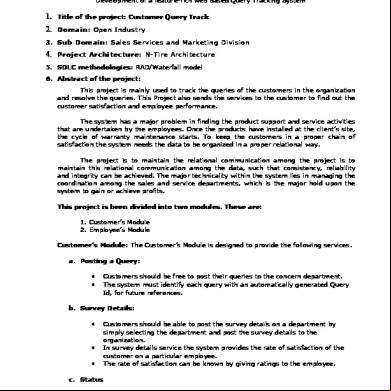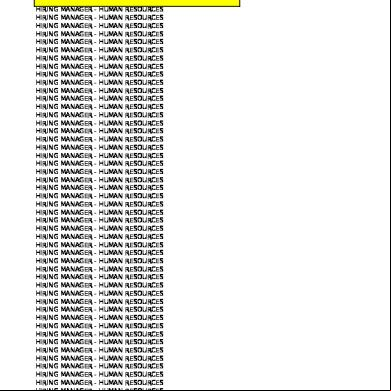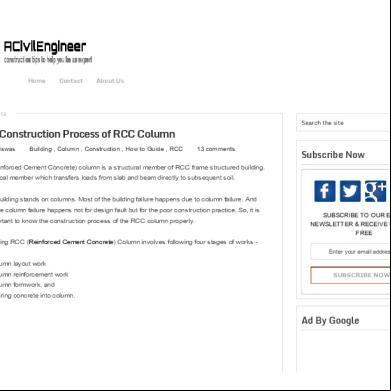Hierarchies In Sap Bw 44111h
This document was ed by and they confirmed that they have the permission to share it. If you are author or own the copyright of this book, please report to us by using this report form. Report 3i3n4
Overview 26281t
& View Hierarchies In Sap Bw as PDF for free.
More details 6y5l6z
- Words: 471
- Pages: 2
Hierarchies Definition A hierarchy is a method of displaying a characteristic structured and grouped according to individual evaluation criteria. A BW hierarchy has the following properties:
Hierarchies are created for basic characteristics (characteristics containing master data). The characteristic 0COSTCENTER is an example.
Hierarchies are stored in master data tables. They are also similar to master data, and can therefore be used and modified in all InfoCubes.
You can define several hierarchies for a single characteristic.
A hierarchy can have a maximum of 98 levels.
You can load hierarchies from the R/3 system, or from a flat file. You can also create and change hierarchies manually in the BW system.
Use Hierarchies are used in two main ways:
Firstly, the structured display of characteristic values (tree display) in a presentation hierarchy.
Secondly, selecting a defined quantity of characteristic values as a selection of hierarchy nodes.
Structure A hierarchy consists of nodes. A node can be assigned to a higher level node. There is exactly one top node (root). All nodes on the same level of the hierarchy (nodes that are the same distance away from the root) form a hierarchy level. A characteristic hierarchy consists of nodes that can and nodes that cannot be posted to. Hierarchies can be created only for those characteristics that do not reference other characteristics. (See also: Creating InfoObjects: Characteristic).
The characteristic Cost Element can be structured according to cost element groups. The highest hierarchy level consists, for example, of personnel costs, material costs, istration costs, and so on. Personnel costs are divided up, for example, into the cost element groups pay, salaries, and personnel overhead costs. The cost element group ‘pay’ contains the cost elements ‘individual pay costs’, ‘pay overhead costs’ and ‘other pay costs’.
Another typical example of a characteristic hierarchy is the grouping of the characteristic Region into districts that are themselves sub-divided into areas.
Integration You can
load characteristic hierarchies from a source system The source system can be an R/3 OLTP system or an external system (BAPI, file). If you want to load a hierarchy from an external system, you have to first maintain the Metadata for this hierarchy. You can load a hierarchy directly from an R/3 system – the Metadata is already delivered with it. See: Loading Hierarchies
create characteristic hierarchies in the Business Information Warehouse See: Creating Hierarchies
If you are working with aggregates and are loading or creating new hierarchies, or changing existing hierarchies, you have to reconstruct the aggregates that are affected by the changes afterwards (see: Adjusting Changes to Hierarchies and Attributes).
Prerequisites You have to determine in the InfoObject-Maintenance whether or not you want the characteristics to have hierarchies. The properties of the hierarchy (for example, the hierarchy versions, time-dependent hierarchy structure) are also defined here.
Hierarchies are created for basic characteristics (characteristics containing master data). The characteristic 0COSTCENTER is an example.
Hierarchies are stored in master data tables. They are also similar to master data, and can therefore be used and modified in all InfoCubes.
You can define several hierarchies for a single characteristic.
A hierarchy can have a maximum of 98 levels.
You can load hierarchies from the R/3 system, or from a flat file. You can also create and change hierarchies manually in the BW system.
Use Hierarchies are used in two main ways:
Firstly, the structured display of characteristic values (tree display) in a presentation hierarchy.
Secondly, selecting a defined quantity of characteristic values as a selection of hierarchy nodes.
Structure A hierarchy consists of nodes. A node can be assigned to a higher level node. There is exactly one top node (root). All nodes on the same level of the hierarchy (nodes that are the same distance away from the root) form a hierarchy level. A characteristic hierarchy consists of nodes that can and nodes that cannot be posted to. Hierarchies can be created only for those characteristics that do not reference other characteristics. (See also: Creating InfoObjects: Characteristic).
The characteristic Cost Element can be structured according to cost element groups. The highest hierarchy level consists, for example, of personnel costs, material costs, istration costs, and so on. Personnel costs are divided up, for example, into the cost element groups pay, salaries, and personnel overhead costs. The cost element group ‘pay’ contains the cost elements ‘individual pay costs’, ‘pay overhead costs’ and ‘other pay costs’.
Another typical example of a characteristic hierarchy is the grouping of the characteristic Region into districts that are themselves sub-divided into areas.
Integration You can
load characteristic hierarchies from a source system The source system can be an R/3 OLTP system or an external system (BAPI, file). If you want to load a hierarchy from an external system, you have to first maintain the Metadata for this hierarchy. You can load a hierarchy directly from an R/3 system – the Metadata is already delivered with it. See: Loading Hierarchies
create characteristic hierarchies in the Business Information Warehouse See: Creating Hierarchies
If you are working with aggregates and are loading or creating new hierarchies, or changing existing hierarchies, you have to reconstruct the aggregates that are affected by the changes afterwards (see: Adjusting Changes to Hierarchies and Attributes).
Prerequisites You have to determine in the InfoObject-Maintenance whether or not you want the characteristics to have hierarchies. The properties of the hierarchy (for example, the hierarchy versions, time-dependent hierarchy structure) are also defined here.










